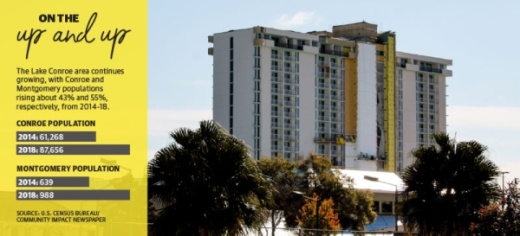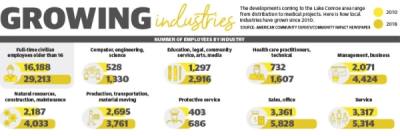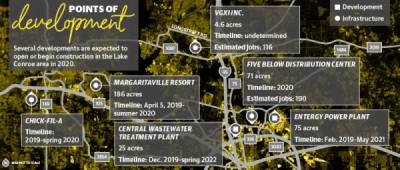Conroe saw about a 43% increase in population from 2014-18 while the city of Montgomery grew about 55%, according to the U.S. Census Bureau. And the Lake Conroe area’s population continues to burgeon, with a growth rate nearly double the Greater Houston area's, according to a study by Community Development Strategies, a professional market and economic research consultant.
“It’s been interesting to see that much growth in that short amount of time,” said Danielle Scheiner, the executive director of the Conroe Economic Development Council.
Alongside population growth, the area is experiencing a boom in development, particularly in manufacturing and distribution. Development projects slated to be completed or make headway this year in the Conroe and Montgomery area include an 860,000-square-foot distribution center in the Conroe Park North Industrial Park and medical research developments in the Deison Technology Park as well as the Margaritaville Resort on Lake Conroe.
But a rise in population also poses infrastructure challenges, and officials said they must be cognizant of balancing new development while still maintaining the area’s history.
“As exciting as all that [development] is, it brings a lot of challenges that we have to look at [on a] daily basis to make sure we’re keeping our public safe,” said Nancy Mikeska, the director of community development for the city of Conroe.
The new Conroe
Scheiner said she can remember what Conroe looked like when she first moved to the city in 1999. There were far fewer stores and outlet centers, and I-45 was four lanes, she said.
“What’s funny is that it happens over time; you almost don’t notice,” Scheiner said. “It just kind of builds up all around you, and you notice more cars on the road and stuff.”
The city’s population has grown from 56,207 in 2010 to 87,656 in 2018, according to the U.S. Census Bureau. The Lake Conroe area also added 29,100 residents with at least a bachelor’s degree to its workforce between 2010-17, according to the study by Community Development Strategies.
As the city’s overall population and educated workforce grow, Scheiner said there are five markets which the CEDC is actively seeking to grow: manufacturing, life sciences, logistics, energy services and avionics.
One distribution and manufacturing development coming down the pipeline this year is an 860,000-square-foot Five Below distribution center for children’s retail in the Conroe Park North Industrial Park. According to the U.S. Securities and Exchange Commission, the entire project is expected to cost $56 million by the time it opens in June.
“It will be the largest building out there [in the industrial park] once it’s complete,” Scheiner said.
Other projects in the works this year include a 200,000-square-foot office, manufacturing and research facility for VGIX Inc., a medical research company based in The Woodlands. Conroe City Council approved a $1.2 million incentive for the $17.2 million facility during a special meeting Nov. 25.
This project would be the first tenant in the Deison Technology Park since it was completed six years ago. During the special meeting, Scheiner said the facility will employ 116 people with an average salary of $75,000.
Resort on Lake Conroe
Not all upcoming projects are related to manufacturing and distribution. Mikeska said one of the most impressive new projects in Conroe will be the Margaritaville Resort on Lake Conroe.
“All of the property out in that area has always been prime location and beautiful, but bringing in something that is going to be a fun place for families and young adults and those kind of things is going to be a great addition out there,” Mikeska said.
The 186-acre resort, located at the former La Torretta Resort, is set to open this summer and will feature an 18-hole golf course, two restaurants, a water park, boating, fishing and other lake activities. The resort will also be open for meetings and events with its 72,000 square feet of meeting space.
The resort will be the franchise’s first Texas location.
Montgomery Mayor Sara Countryman said the Margaritaville Resort is the top project near the city of Montgomery as well and will bring in businesses and crowds of tourists, especially those who want a more historic experience.
Laying the foundation
Scheiner and Mikeska said a challenge that comes with population and development growth is making sure the city has the capacity to serve all the businesses and residents.
Mikeska said access to city water and sewage is a priority for many developers. Construction began Dec. 2 on the city’s new $60 million wastewater treatment plant, which will open in spring 2022 and pump an average of 6 million gallons a day.
Meanwhile, Scheiner said she hopes Conroe is able to maintain its identity even as the growth explodes.
“When you go downtown and you go to the grocery store, it still has that air about it; the people are still warm and friendly,” Scheiner said. “And I would like to see that despite all this growth that we’re having that it still feels authentic and real and it still feels like a community people want to be a part of.”
Like Conroe, the city of Montgomery is also working to manage the growth of the area while maintaining its identity. Countryman said she receives calls weekly from developers who are interested in coming to the area, such as the Chick-fil-A expected to open in the spring.
“Not everyone’s a fit, but they certainly want to understand our leadership,” Countryman said.
City Administrator Richard Tramm said in 2019, Montgomery laid the groundwork for its inevitable growth, including increasing the budget for roadways and sidewalks and partnering with Texas A&M University to draft conceptual designs for specific issues the city faces, including downtown revitalization, historic preservation and tourism, ecological connectivity, walkability and active living and new residential typologies.
The designs will be incorporated into the city’s greater master plan for the city’s growth, which is expected to be finalized in February.
Countryman and Tramm said in order to preserve the historical character of Montgomery, the city has to create a relationship between the city and the developers.
“Part of it is helping [to identify] what is special about Montgomery,” Tramm said. “By helping them with a little bit of education ... incorporating a little bit of the Montgomery charm and the history into what they’re making helps make it part of the Montgomery identity.”







